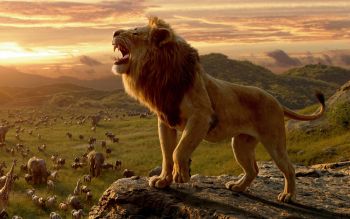Difference between revisions of "Lion"
Tao alexis (talk | contribs) |
Tao alexis (talk | contribs) |
||
| Line 18: | Line 18: | ||
| special = [[Pounce (attack)|pounce]], [[Raking|raking]], [[Surprise (combat)|surprised only on a 1]] | | special = [[Pounce (attack)|pounce]], [[Raking|raking]], [[Surprise (combat)|surprised only on a 1]] | ||
}} | }} | ||
| − | '''Lions''' are | + | '''Lions''' are large cats most common in Africa and India, spanning a much wider range in the 17th century than many might suppose. They dwell upon open grasslands north of Persia and the Caucasus and throughout the Middle East. As hunters, the dislike dense forests, preferring open country. Their most common prey consists of large hoofed mammals. |
| − | [[File:Lion.jpg|left| | + | [[File:Lion.jpg|left|350px]] |
| − | + | A social species, lions form groups called "prides," consisting of a few adult males, related females and cubs. Groups of females like to hunt together, while males tend to act as solitary hunters. Lions have been known to pull down prey as large as an [[African Elephant|elephant]]. When desperate for food, lions will attack [[Humanoid|humanoids]] — typically, lions keep their distance from settlements. | |
Lions are muscular, varying in colour from light buff to silvery grey, yellowish red and dark brown. Rarely, lions can be white, though this is not a sign of being albino. It is the only member of the cat family that displays obvious sexual differences between male and female. The male lion's mane is the most recognisable feature of the species, which the female does not possess. Lions spend much of their time resting; they are inactive for about 20 hours a day. Their activity generally peaks after dusk with a period of socialising, grooming and intermittent bursts of activity that last until dawn, when hunting most often takes place. | Lions are muscular, varying in colour from light buff to silvery grey, yellowish red and dark brown. Rarely, lions can be white, though this is not a sign of being albino. It is the only member of the cat family that displays obvious sexual differences between male and female. The male lion's mane is the most recognisable feature of the species, which the female does not possess. Lions spend much of their time resting; they are inactive for about 20 hours a day. Their activity generally peaks after dusk with a period of socialising, grooming and intermittent bursts of activity that last until dawn, when hunting most often takes place. | ||
Revision as of 19:34, 20 June 2022
| Species | feline |
| No. Appearing | 5–15 |
| Behaviour | social (family) |
| Range | desert, savanna, steppe, veldt |
| Size | 9 ft. 4 in. long |
| Weight | 450 lbs. |
| Intelligence | 2 |
| Armour Class | 5 |
| Hit Dice | 5+2 |
| Action Points | 6 |
| Max. Stride | 14 |
| THAC0 | 18 |
| Hp/Die | 2d4 |
| Attack Forms | 3: two claws; fangs |
| Damage | claw (1–8); fangs (2–16) |
| Special Attacks | pounce, raking, surprised only on a 1 |
Lions are large cats most common in Africa and India, spanning a much wider range in the 17th century than many might suppose. They dwell upon open grasslands north of Persia and the Caucasus and throughout the Middle East. As hunters, the dislike dense forests, preferring open country. Their most common prey consists of large hoofed mammals.
A social species, lions form groups called "prides," consisting of a few adult males, related females and cubs. Groups of females like to hunt together, while males tend to act as solitary hunters. Lions have been known to pull down prey as large as an elephant. When desperate for food, lions will attack humanoids — typically, lions keep their distance from settlements.
Lions are muscular, varying in colour from light buff to silvery grey, yellowish red and dark brown. Rarely, lions can be white, though this is not a sign of being albino. It is the only member of the cat family that displays obvious sexual differences between male and female. The male lion's mane is the most recognisable feature of the species, which the female does not possess. Lions spend much of their time resting; they are inactive for about 20 hours a day. Their activity generally peaks after dusk with a period of socialising, grooming and intermittent bursts of activity that last until dawn, when hunting most often takes place.
Attacks
When the lion attacks, at the end of its rush it will leap four combat hexes following its movement, enabling it to close the distance quickly with its prey, even when moving warily. They will attack with their claws and fangs. If the lion strikes with both forepaws, it will then get two additional attacks, raking with the rear claws, each causing 2-8 damage.
The lion is very observant in its habitat and cannot be easily startled. It is therefore only surprised on a 1 in 6.
See Bestiary
